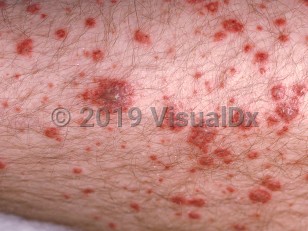Immunoglobulin A vasculitis in Child
Alerts and Notices
Important News & Links
Synopsis

IgAV is characterized clinically by palpable purpura, abdominal pain, arthritis, and hematuria. Children are more likely to have fevers and abdominal pain. There are prodromal symptoms of malaise, headache, and arthralgias. An individual episode may persist for 3-6 weeks, with recurrences in many patients.
Almost all patients develop palpable purpura. Other skin involvement may include petechiae, bullae, edema, and necrosis. Infants' skin involvement is sometimes limited to the face or arms. Joint abnormalities are the second most common symptom and may accompany skin eruptions with severe pain and sometimes swelling, warmth, and tenderness. Ankles and knees are most often involved; symptoms are often transient and migratory.
Severe abdominal pain, vomiting, hematemesis, diarrhea, and hematochezia occur in about 50% of children. An involved inflamed and edematous bowel may be accompanied by appendicitis, ileus, and infarction. Intussusception and bowel perforation are more common in children than in adults.
Renal involvement occurs in 20%-50% of children and is usually self-limited, with only 1%-3% of patients progressing to end-stage renal disease. Risk factors for more severe renal disease include increased age at presentation, increased levels of serum IgA, and baseline nephritic or nephrotic disease. Notably, skin lesions above the waist may indicate higher risk in adults, but studies have not shown this in children.
Codes
D69.0 – Allergic purpura
SNOMEDCT:
191306005 – Henoch-Schönlein purpura
Look For
Subscription Required
Diagnostic Pearls
Subscription Required
Differential Diagnosis & Pitfalls

Subscription Required
Best Tests
Subscription Required
Management Pearls
Subscription Required
Therapy
Subscription Required
Drug Reaction Data
Subscription Required
References
Subscription Required

